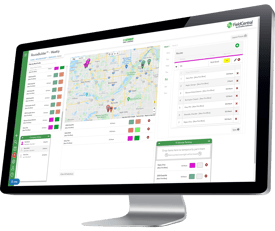
Field service business, by its very nature, involves driving around to multiple sites to conduct business. On any given day, multiple hours of driving have consumed your employees’ schedules. Between personal and business texts, mapping routes, talking and entering data, your workers have lots of cell-phone temptations distracting them away from their driving. Unfortunately, your business could be sued for up to $25 million for an employee’s cell-phone related crash, even if it’s due to a personal call or off the clock. Here’s what you need to know about cell phones and your field service business:
1. Cell phone use while driving increases risk of injury by 400%
If an employer knew a behavior in some area of its operations made workers 4 times more likely to get injured, would that employer allow or encourage that behavior? That is exactly what is happening when employers have no policy against cell phone use while driving. Employers who expect their employees to use cell phones while driving are exposing their workers to preventable crash risks. According to a 2011 CDC report, motor vehicle crashes are the number one cause of work-related deaths. Why increase this risk for your employees?
2. Texting while driving makes a crash 23x more likely
Texting while driving is 6 times more likely to cause an accident than driving drunk. Texting takes your eyes of the road, hands off the wheel and mind off driving, which makes it the most dangerous of any of the common driving distractions. Texting takes drivers’ eyes off the road for an average of 5 seconds at a time. At 55 mph, that would equate to driving the length of a football field essentially blind. Unfortunately, even voice-activated messaging and email, which is supposed to keep your eyes on the road, isn’t safe and is associated with the highest level of dangerous cognitive distraction while driving. Texting while driving causes 1.6 billion car accidents, 330,000 injuries and over 3000 deaths each year in the US. Don’t let one of your employees become one of those statistics.
3. State laws and national recommendations
Forty-four states and the District of Columbia have banned texting while driving. Fourteen states have banned all hand-held cell phone use while driving – including dialing and talking on the phone (click here to look up your state’s laws). Unfortunately, these laws don’t meet the recommendations set by the National Transportation Safety Board (NTSB). In December 2011, the NTSB recommended a complete ban on all portable electronic devices for all drivers after reviewing numerous serious and fatal crashes that involved cell-phone use. One such accident involved a tour-bus driver who crashed into a low bridge while talking on a hands-free cell phone. The bus driver reported not seeing either of the 2 warning signs or the bridge before the impact that destroyed the bus and injured 11 students, one seriously.
4. Employers will be held liable up to $25 million
On-the-job crashes cost employers more than $24,500 per property-damage crash and $150,000 per injury crash according to the US Dept. of Transportation. Unfortunately, it gets even worse when an employee is using their phone around the time of a crash, because the employers are being sued for crashes involving cell-phone use if they did not enforce policies banning cell-phone use while driving. Here are some examples:
- A jury found that a driver and the company that owned the vehicle were liable for $21.6 million because the driver was on a personal call at the time of the fatal crash and the company had no policy banning cell-phone use while driving.
- An employee was making a cold call on the way to a non-business event on a Saturday night when he caused a fatal crash. His company did not own the phone or the vehicle, but were held liable for $500,000 because they encouraged employees to use phones in the car and didn’t have any policy governing safe cell-phone use.
- A construction-company employee reached over to retrieve a message from a hands-free mounted cell phone provided by his employer, when he crashed into a sedan that had stopped in front of him to turn left. The passenger of the sedan was severely injured. The company tried to argue that the employee was commuting to work and wasn’t on the clock, but because it was a company cell phone and he was attempting to return a company phone call, the employer was liable for $4.75 million.
These are just a few examples of the many lawsuits that have plagued businesses in recent years because of cell-phone-related crashes. These examples and many more can be found on a recent report from the National Safety Council (NSC).
5. How to minimize accidents and liability
To prevent cell-phone-related crashes and the liability they bring, companies need to implement a cell-phone policy. The NSC offers a free kit with materials to build leadership support and communicate with employees. The cell-phone-ban policy needs to cover the following components to meet NTSB recommendations:
- No cell-phone use of any kind (hand held or hands free) while driving in the following circumstances:
- Always park in a safe location before using cell phones in any of the above situations.
For the ban to be effective, employers have to continually follow these 4 steps recommended by the NSC:
1. Educate employees
2. Monitor compliance
3. Enforce the policy
4. Address violations
Without follow through, your policy will be ineffective and your goals to protect your employees and company will fall through.
6. Cell-phone policies can increase productivity
Generally companies believe that banning cell phones while driving will decrease productivity. Several studies have demonstrated that productivity has either remained the same or increased after implimenting the NSC's cell phone policy. Read more about this on the NSC's report.
When I first read that all cell phone use increases crash risk by 4 times and that the NTSB was recommending that all phone use be banned while driving, I thought it was a little too extreme. After looking at the research, reading the stories and seeing pictures of the accidents caused even by hands-free cell phone use, I realized that I had sorely underestimated the danger of talking on the phone while driving. Take the time to read through the NSC website before you make a decision for your company. At the very least, educate you employees about the dangers of cell phone use while driving and make sure your employees aren’t texting or typing while driving. Whithout a policy you won’t be protected from a lawsuit, but raising awareness may save someone’s life. Better yet, improve your field-service business by taking the first steps toward by making a cell-phone policy today.
Download our eBook below for tips and tricks on how to hire the best for your business!








